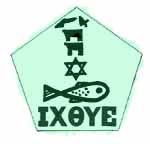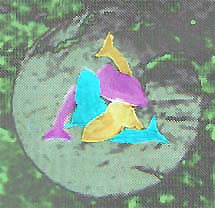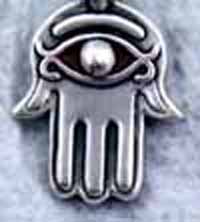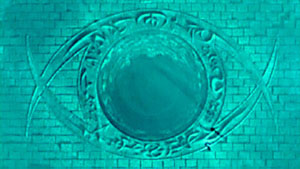
ICTHUS
- (ICHTHYS) - THE SECRET TEACHINGS |
 |
(See words to AMAZING UBB song below)
(We are rendering the word "Ichthys" as "Icthus" to avoid confusion over the pronounciation of the sounds"ch" and "y." We wouldn't want it wrongly coming out as "Itch These.")
Here we will establish that Icthus, otherwise known in his day as Yaohushua, known to most as Jesus, was in fact a Ghu-on'uth (hybrid human/Deep One).
What first needs to be established is how this could be, from the line of descent. That is quite easy.
There was a woman named Ruth from the land of Moab. Dagon was the god worshiped in Moab and Ruth was a Priestess to the deity Dagon. She left Moab and married Boaz and bore him a son that she named Obed, a name that still carries meaning to those in the know. Using the matrilineal line of descent, Icthus is her descendent. That is why the secret teachings bridge the gap of many generations in understanding that the person known as Jesus was in fact Icthus and was also secretly called Dag.
However, things don't just go from this important line of descent. Icthus was the physical son of Dagon Himself, born by his mother Mary, whose name means "of the sea." He was not Joseph's biological son at all. Some dispute this and claim that Icthus was Yaohu-ul (otherwise known as YHVH) incarnated, but that would be referring to the Spirit, not the actual flesh, which requires a mother and father, ova and sperm. That he was known as Dag, "little fish," clues us into the true fleshly paternity.
The Catholic Encyclopedia informs us that Dagon was the national deity of the Phillistines. The name Dagon is a diminutive form, hence a term of endearment, derived from the Semitic root dag, and means, accordingly, "little fish." The name, therefore, indicates a fish-shaped God. The Bible also states this when speaking of the Dagon worshiped in the temple of Azotus (I K., v, 1-7): he had face and hands and a portion of his body resembled that of a fish, in accordance with the most probable interpretation of "the stump of Dagon" (verse 5). The Septuagint also shows that Dagon also possessed feet. The description found in the Bible coincides that which may be seen on the coins of various Philistine or Phænician cities, on most of which Dagon is represented as a composite figure, human as to the upper part of the body, fish-like as to the lower. From this it may well be inferred that Dagon was a fish-god, a fact not in the least surprising, as he seems to have been the foremost deity of such maritime cities as Azotus, Gaza (the early sites of which are supposed to be buried under the sand-mounds that run along the sea-shore), Ascalon, and Arvad. In the monuments -- also most probably in the popular worship.
One of the most recognizable articles of clothing the Roman Catholic Pope wears is the tall hat called the mitre. The fact is the origin of the hat goes back long before Icthus and can be traced to the more ancient Dagon. There's nothing in the Bible that indicates that Icthus wore such a hat. Why does the Pope wear it? Because the Pope, having access to the vast Vatican Library, knows the secret teachings of Dagon, otherwise known as Icthus born of Mary! Or, at least the first Pope was an Initiate in these Esoteric Teachings and the rest of the Popes simply carried on the tradition of wearing the mitre. (We have not been in contact with Popes for a very long time).
| Here you can see the ancient
headress of the Priest of Dagon: |
Here you can see the mitre
of the Pope of the Catholic Church: |
The earliest known literary reference to the Icthus ("ichthys") as a symbol of primitive Christianity was made by Clement of Alexandria (c.150-c.215), but the ichthys is also seen in first century catacombs in Rome. It was used as a secret code in the early days of Christianity, when Christians were suffering persecution, to enable them to determine friend from foe.
Lady Ellenborough had a talisman in her possession, presented to her by a Druse from Mount Lebanon. It belonged to a certain class of gems known in Palestine as a Messianic amulet of the 2nd or 3rd century BC. It is a green stone of pentagonal form. At the bottom is engraved a fish; higher is Solomon's Seal (6 pointed star); still higher are engraved the four Hebrew letters Yod He Vau He, Yeve (earlier, Yaohu), which form the name of the Deity. These letters are arranged in an unusual way running from below upward, in reversed order and forming an Egyptian Tau (T). The Tau is considered a representation of the Tree of Life by many occultists. Here is an accurate drawing of the talisman.
Messianic Amulet:

Note also that the two letters "He," one atop the other, form the verticle portion of the "T." To the upper left of the top "He," there is the "Vau," and to the upper right of the top "He," there is the "Yod." The "Vau" and "Yod" form the top horizontal bar of the "T." The secret meaning of these four letters, which also spell out YHVH, esoterically mean "male and female."
Icthus was known to be a revealer of mysteries like the Oannes, a revealer of knowledge extraneously, not known or discovered inwardly. The conjunction of Saturn and Jupiter in Pisces was considered the sign of his coming.
During the middle ages, a very common figure of a Christian symbol was fishes interlaced into a triangle and having the Greek word Ichthys engraved on it. This is another synthesis of three fish instead of the Three Fates in a triangle, as this image below shows. The Three Fates were always women. Recall the Three Marys that visited Icthus and then look again at the image of the three intertwined fish. The three Mary's, had On-dy'uth (Deep One) blood.
This is the esoteric symbol of the Three Fishes

The Greek word in the New Testament repeatedly used and translated "saved" or "salvation" is Sothis and Sothesetai, as in the Gospels of Mark and Luke. Sothis is also a name for the star Sirius. Icthus stated that unless someone be "born or generated physically out of water - and also spirit - he may not enter the Kingdom of God (John: 3:5). The emphasis is on the water.
According to a hymn of the 10th century AD sung at the Annunciation, Mary is "star of the sea, gracious Mother of God and always Virgo, Happy Gate of Heaven." Early Christian syncretists in Egypt identified John the Baptist, who preceded Icthus, with the Chaldean Oannes. The letter "M" as in the names "Marsh" and "Mary" is also special. This is a glyph originating in the ancient water sign, which looks like the letter "M."
You will also recall the announcement to Mary of her Divine Motherhood according to Luke: 1:26. The Archangel Gabriel took on the form of a toad, bearing in his hands to Mary a giant water-lily. This was also a popular early Renaissance form, therefore it was known earlier by others. Egyptians believed in this and in "Khnoum" or "Toom," which is a Lord of the Great Deep Waters. The toad stands for the resurrection and eternal life, after the physical transformation. As the earliest Christians knew and showed, the special votive lamps show a toad or frog enshrined in a lotus flower with Greek Script engraved saying "Ego eime anastasis," meaning "I am the resurrection."
Of course, you have heard of and/or chanted one of our chants: "Mene, mene, tekel upharsin." This is Chaldean and is a hymn to Mene, the Egyptian King identified with Osiris. We do not worship Osiris but we do honor Osiris in a form of "Toom" or "Thoom" or "O-toom," i.e., Cthulhu.
In the name Moses, we again see the glyph "M" and recall that the Pharoah's daughter, finding Moses in the Nile, named him Mose or Moshe because "she drew him out of the waters." Where in Exodus it says the face of Moses "shone," we can see that this referred to the reflectiveness of scales on his face. Moses' alleged language barrier or speech impediment was due to Moses having a non-human larynx. Of course, Moses had powers over the waters, as when he parted the Red Sea, or when God sent the plague of frogs upon Egypt in his name, or his teaching that only earth and water can bring forth a living soul.
Where the Old Testament says in Job 26:5 "Rephaim
are formed from under the waters and inhabitants thereof," Rephaim is Hebrew
for the large octopoidal, original spawn of Cthulhu, the Cthulhi.
Recall Jesus's parable of the "seeds which are sown but get choked off."
Now, this ties into the well known New Testament prohibitions against "fornication"
which, in the New Testament, specifically mean incest, sodomy, and adultery.
St. Paul agrees. We must outbreed and send our seed across the world, even across
lines not usually crossed. To this end, we honor Shub-Niggurath, the God of
Miscegenation (outbreeding).
In Revelation Chapter Four you can clearly read where the Bible speaks of "twenty-four elders," the Elders of R'lyeh surrounded by a green glow. The four great beasts with "eyes within and without and all around" are obviously and recognizably Shoggoths, the green place envisioned, of course, is "R'lyeh," and that which is sealed by the seven seals to be released by Icthus is none other than Cthulhu! However there is more to this re-emerging Icthus when He sets about to do this, and we shall elaborate on that.
Nyarlat (known in Egypt as Nyarlathotep) is the Soul and Messenger of all of the Old Ones. As we know, Yog-Sothoth, also called "Yat-zebaoth, the Gate," was the God of Moses, according to the Zarrians and their human scribe Tierney. Nonetheless, the Soul and Messenger of all of the Old Ones is Nyarlat. While HPL dreamed his dreams of Kadath, he showed that he also knew this about Nyarlat. His word is absolute.
Nyarlat has many times incarnated as a man. One of his incarnations was Set or Seth, the well-known deity from Egypt. It was with a gift from Set/Seth that human beings became aware of their individuality and creativity. Where does this tie in with Icthus, you might ask? We shall explain.
A later Gnostic revelation of Clement of Alexandria's followers, known as the Sethian heresy, claimed that Seth was an earlier incarnation of Jesus. There were mystical Essenes in the first century AD. called Ebionites who believed that the Holy Spirit was female. They understood that Mary was a vessel of this Holy Spirit. Confusion exists about the gender only because they called the human vessels of this spirit "Michael," which literally means, "Who is like God." A further revelation and clarification showed that it was Seth in the line of "Michaels" - i.e., "those who were like God." Seth, one of Eve's children, was the first "Michael," but not Adam. The line has Seth, Enos, Cainan, Jared, Enoch, Methuselah, Lamech, Noah, Abraham, Isaac, Jacob, David, Solomon, Joachim, Mary, Jesus; but the Holy Spirit only entered Jesus at his baptism by John the Baptist. Some earlier experts that knew of this were translators of Coptic texts, like Bridge, such as "The Ethiopian Legends of Our Lady Mary," as well as Bridge's translation of "A Discourse on Mary," by Cyril of Jerusalem appearing in Bridge's "Miscellaneous Coptic Texts." Cyril, in that text, refers to a "Gospel to the Hebrews" that was never found.
Adepts would recognize that the Holy Spirit is none other than Nyarlat, the Soul and Messenger.
So, as you can see, Nyarlat, who took on the form of Set or Seth in Khem and in Stygia before that, and many other forms, has also incarnated in these people named, including "Icthus as the last" (which means, not Icthus at the time he lived, but Icthus to come!).
Some have come to think that Cthulhu was the High Priest of Set. Nyarlat, known as Nyarlathotep, incarnated as Set in Egypt and Nyarlat is the Soul and Messenger of all the Old Ones. Cthulhu is the High Priest of the Old Ones, according to the authority HPL. In that sense, one might say that Cthulhu is a High Priest of Set. However, this might also be wrong. Certain modern-day worshipers of Set feel this is mistaken. Would Cthulhu be the High Priest of an incarnation of Nyarlat as Set? No. Of course not. In this case, Set would be more like Icthus in terms of having human and divine attributes and a body made of flesh and blood. Cthulhu would not be the High Priest of anything incarnated. We think that when Nyarlat was doing such things as incarnations, It was unconcerned with the doings of Cthulhu and, in that sense, was not acting as the Soul and Messenger of the Old Ones but as an incarnation on personal business.
In that sense, then, Nyarlat is the Soul of Icthus after Icthus transcended. As we know from the Bible, when Icthus proved himself to have survived the unjust crucifixion, he appeared to people that did not quite recognize him and he appeared not the same to these various people. He had transformed and he looked different to every person that saw him.
Surely, when he comes to us again, standing
there with a sword, with a tongue that is split, ready to release Cthulhu, he
will be acting in a manner much more typical of Nyarlat.
| Here you can see the ancient Eye of Dagon or "fishcere." | Eye of Dagon as sold in surf shops as the Hand of God, a medallion to be worn around the neck.* |
Here you can see the the Eye of Dagon as used in the Innsmouth EOD. |
 |
 |
 |
*This is actually
a Hamsa amulet, Pre-Judaic, the "Hand of Miriam" or Hamesh Hand. The
Hamsa or Chamsa's (from the Semite root meaning five) includes five digits and
symbolizes the God's protective hand. Five is by itself a number which is associated
with protection. In the Sephardic household the symbol of a fish is also
used to repel the eye and originates from the Talmud. According to some of the
writing it is believed that fish are immune from the evil eye because they are
under water making them effective amulets. Some sources link the significance
of the five fingers to the five books of the Torah, the Jewish name for the
Old Testament scriptures, this significance seems unlikely though as the Hamsa
seems to pre-date Judaism. The fish symbolizes fertility and is commonly
used as a fertility amulet. In Judaism, sometimes Sephardic Jews (a subgroup
of Jews originating in the Iberian Peninsula), use the symbol of a fish in their
household to repel the Evil Eye. This originates from the Talmud - where it
is stated that fish are immune from the evil eye because they are under water,
making a fish an effective amulet.
Amazing Ubb! We hear the Call!
Its word our life secures.
A loving Parent to us all
As long as life endures.
Through many dangers, toils and snares,
We have already come;
’Tis Ubb that brought us safe thus far,
And Ubb will lead us home.
And, when this space and time does
fail,
And all dimensions cease,
We will possess, within the veil,
A life of joy and peace.
The earth will soon dissolve like
snow,
The sun will shine no more;
But Ubb, who made us here below,
Will be just as before.
When we’ve been here ten billion
years,
Bright shining as the sun,
We’ve no less days to sing Ubb’s praise
Than when we’d first begun.